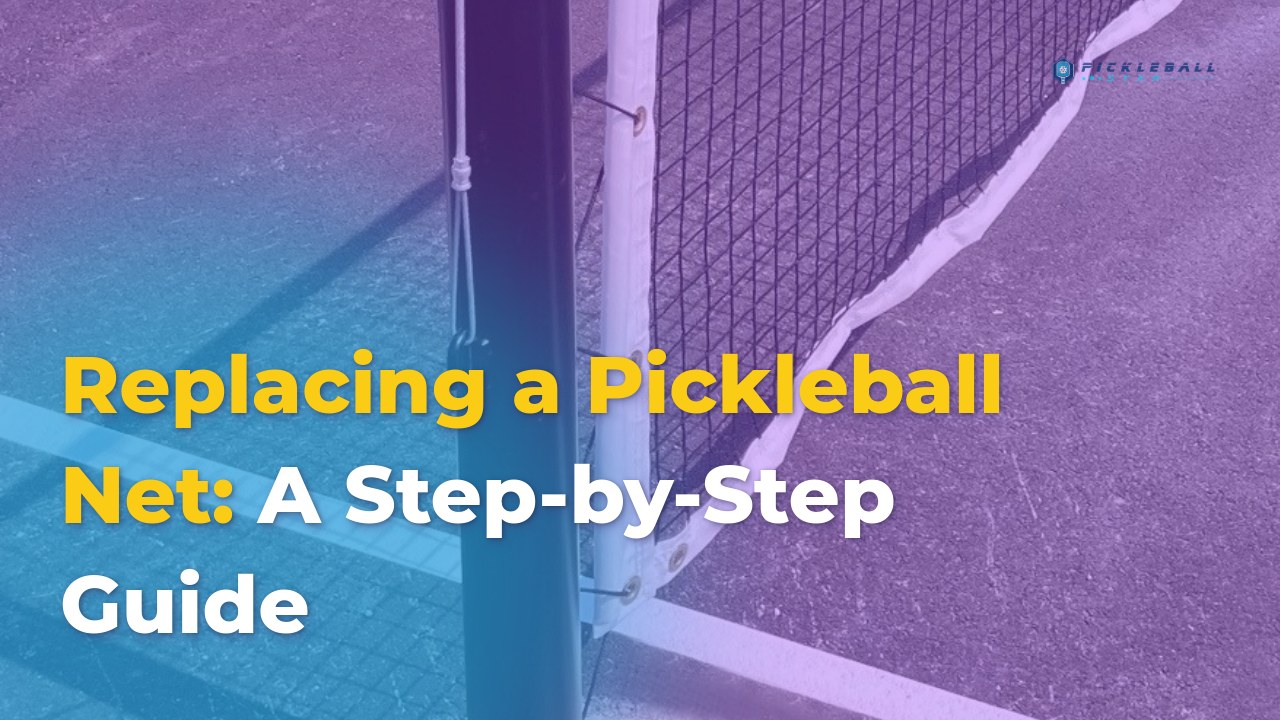Replacing a Pickleball Net: A Step-by-Step Guide
Pickleball nets, like any other sports equipment, experience wear and tear over time. Knowing when to replace your net is crucial for maintaining a safe and enjoyable playing experience. A worn-out net can affect the game’s flow, create safety hazards, and detract from the overall pickleball experience. While replacing a pickleball net might seem like a simple task, it’s important to choose the right net for your specific needs and to understand the proper installation process. A well-maintained and properly installed net can make a significant difference in the quality and enjoyment of your pickleball games.

Signs It’s Time to Replace Your Pickleball Net: Identifying the Need for a New Net
Net Sagging: A Sign of Weakened Material
Imagine playing a game of pickleball, and every time you hit the ball, it struggles to pass over a sagging net. The beauty of pickleball lies in its fast pace and agility, but a sagging net can turn the game into a frustrating challenge. A sagging net happens due to weakened material, often a result of prolonged use and exposure to the elements. Over time, this sagging affects the trajectory of the ball, creating uneven playing conditions and diminishing the fairness of the game.

A real-life example is evident during high-stakes tournaments where the slightest dip in the net could change the game’s outcome. Players might hit a perfect shot, only to have it hindered by an unintended net distortion. This is akin to removing the smoothness from a perfect runway, causing uneven takeoffs and landings. Hence, if you notice your net sagging, it’s a clear indication that replacing it is imminent.
Tears or Holes: Safety Hazards and Reduced Playability
The presence of tears or holes in a pickleball net is not just an aesthetic concern but a serious safety hazard. Imagine running towards the net for a quick volley, only to trip over a gaping hole. Safety and playability are the cornerstones of any sport, and damaged netting can disrupt both. Tears and holes also compromise the integrity of the game, as defects may cause the ball to slip through unexpectedly, affecting the point and leading to disputes.
For instance, consider a scenario where an intense rally is abruptly interrupted because the ball found an unintended passage through a hole in the net. This is not just unfair but also discouraging for players who strive for excellence. Therefore, significant tears or holes are critical signals that your net’s time is up.
Loss of Tension: A Less Responsive Playing Surface
A pickleball game thrives on the consistent bounce and response of the ball, making the net’s tension a crucial factor. A net that has lost its tension is similar to a poorly tuned musical instrument – it just won’t produce the right notes. This loss of tension affects the ball’s bounce, creating an uneven playing surface and making it difficult to control shots.
A common scene that illustrates this is watching players adjust their strikes due to an unpredictably loose net. The art of trajectory and spin is lost, and precision takes a backseat. The loss of net tension, thus, is not merely a mechanical deficit but a deterrent to the game’s finesse and integrity.
Discoloration or Wear: Signs of a Worn-Out Net
Discoloration or excessive wear and tear on your net isn’t simply a sign of aging but a warning for impending failure. These signs can often be overlooked as minor, but prolonged exposure to the sun, rain, and varying temperatures weaken the materials. This leaves the net more prone to unsightly and problematic defects.
Consider a highly competitive park league where spectators expect top-notch gameplay. A discolored or worn net detracts from this experience. It’s like trying to perform a flawless play on a stage with a tattered curtain – it just doesn’t add up. Therefore, paying attention to these signs ensures your net’s longevity and retains the professional look of your court.
Replacing Your Pickleball Net: A Step-by-Step Guide to Installation

Preparing the Net Posts: Ensuring a Secure Foundation
Before embarking on the installation of a new pickleball net, ensuring the pickleball net posts are in top condition is essential. Begin by thoroughly cleaning the posts to remove any dirt, grime, or rust. A clean surface ensures that clamps and attachments hold firmly, preventing slippage during the game. Checking for damage is also critical – any signs of rust or corrosion should be addressed, possibly by repainting or replacing the posts altogether.
Secure anchoring of the posts cannot be overstated. For permanent net, posts must be deeply embedded and stabilized in the ground, while portable pickleball net should have a heavy, balanced base. This secure foundation is like the roots of a tree; the stronger the base, the more stable the net will be.
Installing the Net: A Comprehensive Guide to Setting Up Your Court
Once the posts are prepared, it’s time to install the net. Here’s a step-by-step guide to ensure proper setup:
- Position the New Net: Start by laying out the new net and positioning it in the center of the court. Ensuring the center band aligns with the court’s center is crucial.
- Attach the Net to the Posts: Thread the net through the clamps on the posts. Use a wrench to tighten the clamps, securing the net to the posts. Ensure the net remains taut and straight throughout this process.
- Adjust the Tension: Using the adjustable tension mechanisms, fine-tune the net so that it offers consistent bounce and resistance.
- Check the Height and Alignment: Use a measuring tape to ensure the pickleball net height is consistent – 36 inches at the sides and 34 inches at the center. A level can also help guarantee that the net is even across the entire width.
The installation process embodies precision and attention to detail akin to assembling a high-precision instrument – each component must be perfectly aligned to achieve optimal performance.
Maintaining the Net: Ensuring Longevity and Performance

Maintenance is the unsung hero in ensuring the longevity and performance of your pickleball net. Regular maintenance activities should include:
- Cleaning: Regularly clean the net to remove dirt, grime, and salt residues, especially in coastal areas.
- Inspecting for Damage: Periodically check for tears, holes, or fraying in the net and cables. Address minor repairs promptly to prevent further damage.
- Lubricating Hardware: Keep the clamps and tension adjusters well-lubricated to ensure smooth operation and prevent rust.
- Proper Storage: If the net is portable, store it in a dry, shaded area when not in use to protect it from UV rays and moisture.
Tips for Prolonged Use:
- Use UV-resistant nets for outdoor courts.
- Replace clamps and tensioners at the first signs of wear.
- Engage in seasonal inspections, particularly after harsh weather conditions.
These practices not only prolong the life of your net but also ensure consistent gameplay every time you step on the court.
Common Questions
Can I repair a damaged pickleball net?
Yes, small tears and holes can often be repaired using durable thread or patches. However, extensive damage usually requires a complete replacement to maintain optimal play conditions.
What are some key differences between different types of pickleball nets?
- Permanent vs. Portable: Permanent nets are sturdier with anchored posts, while portable ones are flexible with a collapsible design.
- Material: Varieties include nylon, polyethylene, and UV-resistant nets.
- Tension Mechanism: Some nets offer adjustable tension, essential for fine-tuning playability.
Read more: Portable vs. Permanent Pickleball Nets: Choosing the Right Setup for Your Game
What are some of the best brands of pickleball nets for different types of courts?
- For Competitive Play: Pickleball Inc. and Douglas provide USAPA-approved, high-quality nets.
- For Recreational Use: Onix and Franklin offer durable and budget-friendly options.
How does the process of replacing a pickleball net compare to other sports net replacements?
Replacing a pickleball net is often simpler than tasks like replacing a tennis net or a soccer goal net, largely due to the smaller size and straightforward anchoring system. Nonetheless, the precision in net tension and height remains equally critical.
Conclusion
Regularly replacing your pickleball net is crucial for maintaining a safe and enjoyable playing experience. By carefully considering your needs and choosing the right net for your court, you can ensure a consistent and rewarding game for years to come. Don’t wait until your net is severely damaged. Inspect your net regularly and replace it when necessary. A new net can make a world of difference in your pickleball game. In the grand tapestry of sports, a well-maintained pickleball net is that essential thread that holds the game together, ensuring every volley, serve, and smash resonates with perfection.
